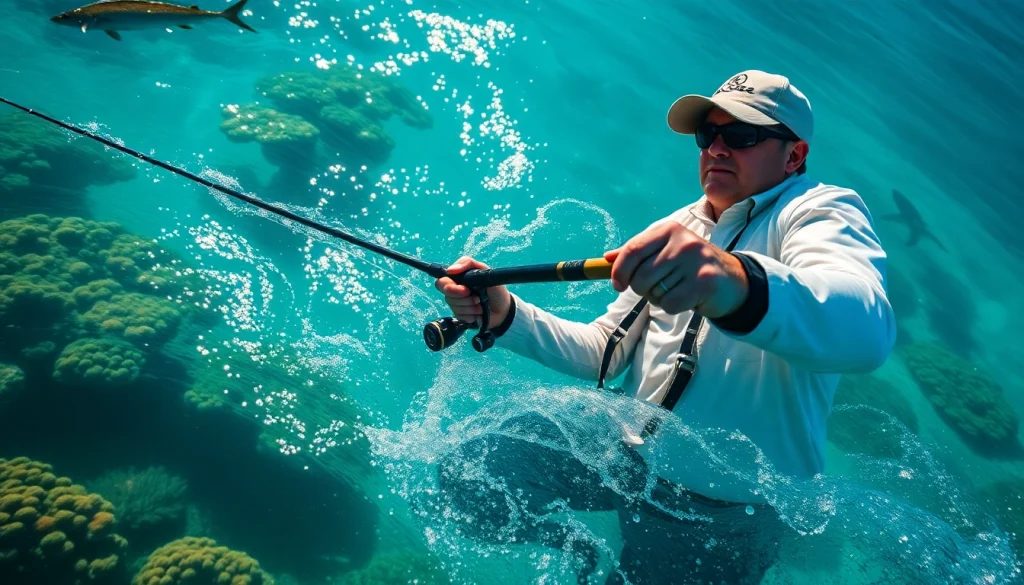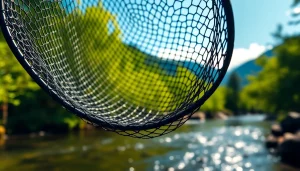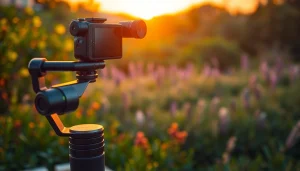A Comprehensive Guide to Mastering Saltwater Fly Fishing Techniques

Understanding the Basics of Saltwater Fly Fishing
Saltwater fly fishing is a thrilling aspect of the angling world that combines skill, strategy, and an appreciation for the beauty of coastal ecosystems. Engaging in this fishing style allows enthusiasts to target a variety of species in vibrant marine environments. Whether you’re a seasoned angler or a newcomer eager to learn, understanding the essential principles of Saltwater fly fishing is crucial for a successful outing.
What is Saltwater Fly Fishing?
Saltwater fly fishing refers to the use of a fly rod and an artificial fly to catch fish in marine environments. It’s a distinct practice that differentiates itself from traditional fishing styles by using lightweight tackle and specialized techniques. Instead of relying on bait, fly anglers mimic the appearance and movement of small fish or other marine organisms using intricately designed flies that are cast with precision.
Essential Gear for Saltwater Fly Fishing
To embark on your saltwater fly fishing adventure, having the right gear is vital. Here are the key components you’ll need:
- Fly Rod: Typically longer and sturdier than freshwater rods, saltwater fly rods range from 8 to 12 feet. They are designed to handle larger fish and windy conditions.
- Fly Reel: A strong, durable reel is necessary for saltwater species. Look for a reel that can withstand the corrosive effects of saltwater.
- Fly Line: Choose weight-forward lines designed specifically for saltwater use. These lines are heavier to facilitate longer casts and better control.
- Leader and Tippet: Generally made from fluorocarbon, the leader should be strong enough to withstand abrasions from rocks and salt. A tippet attached at the end is necessary for attaching your fly.
- Flies: Select a variety of flies that imitate local baitfish or crustaceans. Patterns such as Clouser Minnows and Bonefish Flies are popular choices.
- Accessories: Don’t forget your polarized sunglasses, sun protection (hats and sunscreen), pliers, and a landing net.
Choosing the Right Locations for Saltwater Fly Fishing
Your success in saltwater fly fishing greatly depends on choosing the right location. Popular destinations include:
- Flats: Shallow areas where fish congregate. Look for waters that have surrounding structures such as grass beds or coral reefs.
- Estuaries: Areas where rivers meet the sea. Estuaries provide rich nutrients and are excellent breeding grounds for baitfish.
- Inlets and Jetties: Fish often congregate in these areas due to strong currents that attract baitfish.
Techniques to Improve Your Saltwater Fly Fishing Skills
Improving your techniques can significantly increase your chances of landing that trophy fish. Consider incorporating these strategies into your practice:
Fly Casting Techniques for Saltwater Environments
Perfecting your casting technique is critical in saltwater fly fishing. Master the double haul casting method, which allows for longer casts and better control under windy conditions. Practice casting with varying lines to get accustomed to how they perform, and focus on maintaining a smooth, steady rhythm.
Effective Retrieval Methods for Saltwater Fish
Retrieval techniques can greatly influence your success rate. Learn to vary your retrieve speed and incorporate quick strips, pauses, and twitches. This mimics the erratic movement of baitfish, making your fly more enticing to predators.
Understanding Tides and Weather in Saltwater Fly Fishing
Knowledge of tidal movements and weather patterns can enhance your fishing strategy. Often, fish are more active during specific tidal phases. Plan your outings around these times, focusing on lunar cycles and shifts in weather that may affect fish behavior.
Species Targeted in Saltwater Fly Fishing
Saltwater fly fishing gives anglers the opportunity to target a wide range of species, each presenting its own set of challenges and tactics.
Common Saltwater Fish Species and Their Habits
Some of the most sought-after saltwater species include:
- Bonefish: Often found in shallow waters, they are known for their speed and elusive nature.
- Tarpon: Famous for their aerial acrobatics, tarpon are thrilling to catch and require precise techniques.
- Redfish: Found in estuaries and marshes, redfish are aggressive and often target baitfish.
- Permit: Renowned for their wariness, permit fishing requires skill in presentation and stealth.
Seasonal Migration Patterns of Saltwater Fish
Understanding the seasonal migrations of these fish can improve your chance of success. Fish often follow baitfish, moving between shallow flats and deeper waters. Familiarizing yourself with local patterns will lead to more productive fishing trips.
Match the Hatch: Selecting Flies for Target Species
Selecting the right flies is essential in saltwater fly fishing. Research local baitfish and crustaceans during specific seasons and match your fly selections accordingly. Experiment with different colors and sizes until you find what works best in your fishing area.
Challenges and Solutions in Saltwater Fly Fishing
Every angler faces unique challenges while saltwater fly fishing. Identifying these issues and developing strategies to overcome them is key to a successful experience.
Dealing with Difficult Fishing Conditions
Sometimes, you may experience unpredictable weather or tough conditions that make fishing difficult. Consider adjusting your fishing times, selecting quieter areas, or changing your tackle setup to match the conditions. Adapting to changing tides and winds can make a noticeable difference.
Common Mistakes to Avoid in Saltwater Fly Fishing
Many anglers fall into common traps when starting. Some typical mistakes include:
- Using inadequate gear for the species targeted.
- Failing to pay attention to tide changes and current.
- Overlooking the importance of stealth and presentation.
Reflecting on these mistakes and focusing on continuous improvement will significantly enhance your skills.
Safety Precautions and Best Practices
Safety should always be a priority. Wear a personal flotation device, know the local marine regulations, and be aware of environmental conditions. Ensure you have enough hydration and sun protection during longer fishing trips.
Advanced Strategies for Successful Saltwater Fly Fishing
As you grow in your saltwater fly fishing abilities, consider adopting advanced strategies to enhance your fishing experience.
Fly Fishing Techniques for Specific Saltwater Environments
Different environments may require specific tactics. For instance, when fishing the flats, practice sight fishing to spot fish before they see you. In deeper waters, focus on developing a stealthy approach that reduces disturbance in the water.
Building an Effective Fishing Plan
Creating a strategic fishing plan that includes your target species, preferred fishing locations, and time of day will help maximize your success. Consider consulting local resources or joining fishing communities for insights.
Using Technology to Enhance Your Saltwater Fly Fishing Experience
Incorporate technology, such as fishing apps for tide charts and maps, to inform your fishing strategy. Drones can also survey hard-to-reach areas where fish may be hiding, offering new opportunities for exploration.
In summary, mastering saltwater fly fishing requires dedication, practice, and an understanding of the essential fundamentals, techniques, gear, and strategies. By investing time in learning and adapting to the unique conditions of saltwater environments, you’ll not only increase your likelihood of success but also enhance the joy of experiencing the great outdoors.







